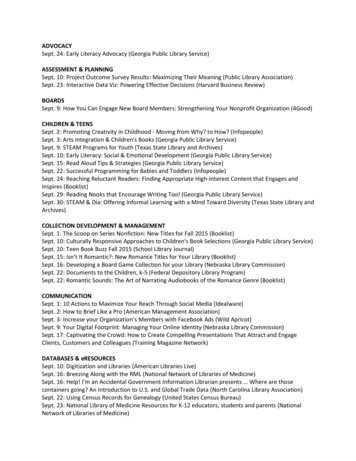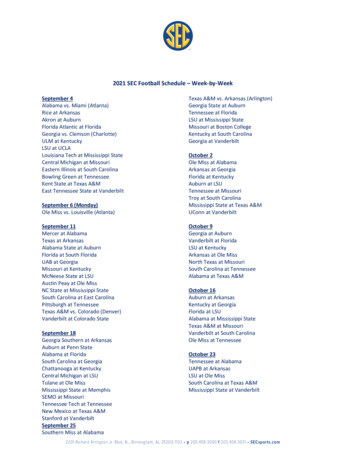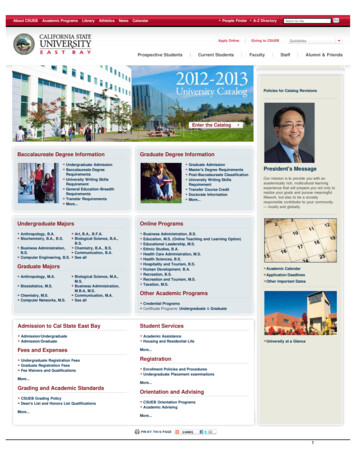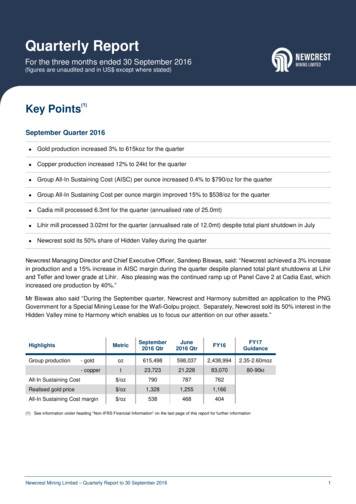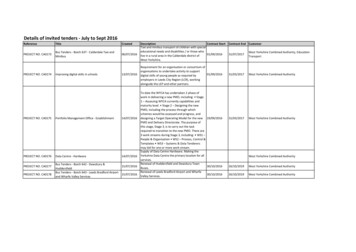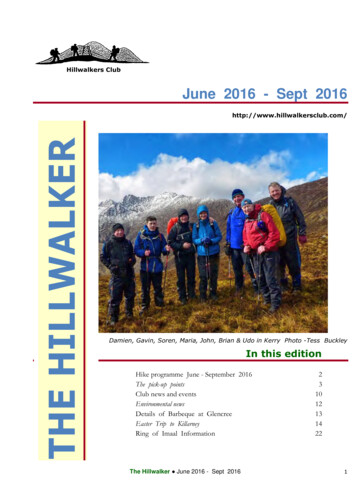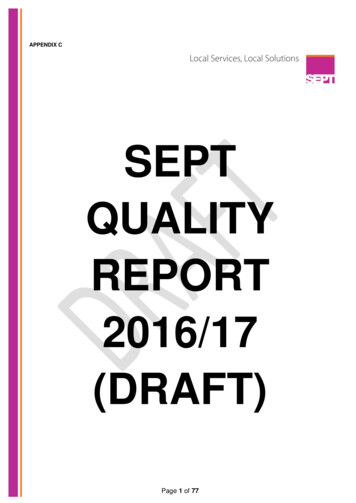
Transcription
APPENDIX CSEPTQUALITYREPORT2016/17(DRAFT)Page 1 of 77
EXECUTIVE SUMMARYWe recognise that for organisations like ours, providing a range of different services, in different geographicareas, this document can be somewhat complex. To help readers navigate our Quality Report, a summary ofcontent and where you can find specific information that you may be looking for is provided below.Part 1 is a statement written by SEPT Chief Executive, Sally Morris, on behalf ofthe Board of Directors setting out what quality means to the Trust and the processes inplace to ensure the highest quality of servicesPart 2 firstly sets out the priorities for improvement for our services in 2017/18(as part of the new Essex Partnership University NHS Foundation Trust)Section 2.1 outlines the actions EPUT intends to take to ensure quality of servicesthrough 2017/18Section 2.2 sets out the quality priorities agreed for the new organisation in 2017/18Section 2.3 details the stretching goals for quality improvement that have been agreedwith health commissioners of our services as part of the CQUIN schemePart 2 secondly reports the required statements of assurance from SEPT as wellas performance against nationally mandated indicators for 2016/17Section 2.4 sets out the mandated statements of assurance from the Boardappertaining to SEPT for 2016/17Section 2.5 reports SEPT’s performance against the national mandated qualityindicatorsSection 2.6 sets out information on SEPT’s progress with implementing the Duty ofCandour and the national Sign Up To Safety campaignPart 3 focuses on ‘looking back’ at SEPT’s performance against quality priorities,indicators and targets during 2016/17Section 3.1 reports progress against SEPT’s quality priorities for 2016/17, outlined inthe Quality Report 2015/16 (including historic and benchmarking data, where this isavailable)Section 3.2 provides examples of some achievements relating to local service specificquality improvement and Trust workforce development during 2016/17Section 3.3 reports performance against SEPT Trust wide and service specific qualityindicators Trust wide local quality indicators Community health services local quality indicators Mental health services local quality indicatorsSection 3.4 reports performance against other national key indicators and thresholdsdefined by NHS Improvement which were relevant to SEPT in 2016/17 and have notbeen included elsewhere in this Quality ReportSection 3.5 details some of the work we have undertaken in relation to capturing patientexperience and using this to help us to improve the quality of our servicesClosing Statement by Sally Morris, Chief ExecutiveAnnexe 1 contains statements received from SEPT’s partner organisations and Councilof Governors. (to be inserted into final version prior to publication)Annexe 2 contains the Statement of Directors’ Responsibilities in respect of the QualityReport. (to be signed by the Board of Directors of EPUT on behalf of SEPT on approvalof final document)Annexe 3 contains the Independent Auditor’s Report to the Council of Governors onthe Annual Quality Report. (to be inserted into final version prior to publication)A glossary of terms is provided at the end of the Quality Report in case it containsjargon which you are not familiar with.Page 2 of 77Page No.379121322313334465454626567717374757677
PART 1: STATEMENT ON QUALITY FROM SALLY MORRIS, CHIEF EXECUTIVE OF SEPT 2016/17I am delighted to present this Quality Report for 2016/17, which shows how South Essex PartnershipUniversity NHS Foundation Trust (SEPT) met its quality commitments for the past year and outlines thequality priorities in 2017/18 for our new, merged organisation – Essex Partnership University NHSFoundation Trust (EPUT).This was an exciting year for SEPT as we prepared to merge with North Essex Partnership University NHSFoundation Trust (NEP) to form EPUT in April 2017. The merger is an excellent outcome for the people whorely on our services. We said from the start that we would be stronger together. Now we can harness the realenthusiasm we have to take the best from both organisations to deliver sustainable and transformativemental health, learning disabilities and community health services for the benefit of local people.However, we didn’t allow the proposed merger to distract SEPT’s continued firm focus on the provision ofhigh quality services. Much of the good practice outlined in this statement and throughout this report hasbeen carried forward into the new organisation, taking us from strength to strength. The formation of EPUTenables us to continue to drive forward these quality improvements and more.The preparation of this Quality Report has been particularly complex this year as we are required to lookback on 2016/17 as SEPT and to look forward to 2017/18 as EPUT. We have tried to make the report aseasy to follow as possible. There are contact points at the end of the report – please do not hesitate to get intouch if you have any queries.Some of SEPT’s quality highlightsQuality highlights from the past year include: Continuing high levels of achievement against the national safety thermometer, a national tool formeasuring the achievement of harm free care.On-going reduction in the number of avoidable category 3 and 4 pressure ulcers acquired in our care,with two out of our three Community Health Services achieving no avoidable category 3 or 4 pressureulcers across the entire year.Acceptance to be part of the NHS Improvement Falls Collaborative which is a 90 day programme,involving 21 volunteer Trusts, designed to improve the management of falls in an inpatient setting byensuring that providers have the information, skills and tools to reduce injurious inpatient falls andimprove reporting and care.On-going implementation of the Trust’s Quality Academy with more than 65 quality champions beingtrained during the year and dates for training more quality champions scheduled.Development and implementation of a new “quality dashboard” for the Trust Board which provides theBoard with an overview of key quality indicators, providing assurance and, where necessary, theopportunity for clarification and challenge.Implementation of a number of actions within the Sign up to Safety Initiative, with strong links to thenational team supporting it.Awarded the Skills for Health Quality Mark Award for education and training.Family Food First – accreditation awarded for a number of local pre-school and nurseries inBedfordshire.Installed a state-of-the-art X-ray machine at Saffron Walden Community Hospital.Launched the “Ask 3 Questions” programme in west Essex.Participated in the Essex-hosted Diabetes Games and Family Fun Day.Achieved excellent PLACE (clinical environment) results – above average in all categories.Received positive feedback following a visit from The Right Honourable the Lord Bradley to ourCriminal Justice Liaison & Diversion Team.Achieved consistently excellent national Staff Survey results.Launched 2017’s Buddy Scheme for training in mental health services.Dr. Ashish Patak, Consultant Psychiatrist, awarded Trainee Leader of the Year in the HealthEducation East Awards.Psychiatrists Dr David Ho, Dr Raman Deo and Dr Vivek Bisht, presented a symposium at theInternational Association of Forensic Mental Health Conference in New York (June 2016).Page 3 of 77
Jacky Syme, practice development manager for 0-19 service in Bedfordshire, received the runner-upaward for the Julie Crawford Award, given by the Baby Feeding Law Group (BFLG). Open Arts recognised again at the National Positive Practice in Mental Health Awards 2016.You will find details of a number of these and many other achievements in this report.Systems for ensuring quality at the highest levels throughout 2016/17SEPT had a number of systems in place to ensure quality at the highest levels throughout the year. Thesesystems have carried forward into EPUT and will continue to evolve as the new organisation develops.As an NHS Foundation Trust, SEPT had a Council of Governors which included elected members of thepublic and staff, as well as a Board of Directors, both of which were led by the Chair of the Trust. Togetherthey ‘drove’ the Trust, ensuring our staff were delivering services to the high standards to which we all aspireand they held me and my executive team to account for the day-to-day running of the Trust.Our Board of Directors met in public and ensured proactively that we focused not only on national targets andfinancial balance, but also continued to place significant emphasis on the achievement of quality in our localservices. Our performance was, therefore, monitored consistently and any potential areas for improvementaddressed swiftly.Robust quality governance systems were in place to safeguard patient safety and, ultimately, to provideassurance to the Board of Directors on the quality of SEPT services. These quality governance systemsincluded production of comprehensive quality (including safety, experience and effectiveness) andperformance dashboards on a monthly basis; undertaking compliance checks mirroring Care QualityCommission’s (CQC) reviews and implementing any necessary remedial actions; an active national and localclinical audit programme; monitoring of patient experience and complaints and a robust risk managementand escalation framework. Visits to services to assess quality and triangulate the information gained fromthese processes were made regularly by Non-Executive Directors, executive directors, Governors andcommissioners.I also place great importance on checking personally that things are as they should be in the Trust. I madeunannounced visits to services at all times of the day and night throughout the year to observe the careprovided and to hear directly from the people using the services at the time.The quality governance system, actual quality performance and assurance on the arrangements in placewere overseen by sub-committees of the Board of Directors and assurance provided to the Board ofDirectors.How others feel about our servicesSEPT placed great importance on listening to, involving and engaging with the people who come into contactwith our services – patients / service users, carers and our staff and volunteers. This will also be a keypriority for EPUT. During 2016/17, we continued to enhance our robust mechanisms for capturing feedbackand also, and most importantly, acting on that feedback and using it to improve and shape services. We haveincluded details of some of the activities undertaken, the feedback gained and changes made as a result insection 3.5 of this report.Listening to our staff and their views on the quality of services was equally important to SEPT and willcontinue to be so in the new organisation. During 2016/17, we continued to ensure that our staff feltsupported and encouraged to speak out about any issues, concerns or challenges. There were robustpolicies in place to enable staff to do this and a number of mechanisms by which they could raise anyconcerns. This included the “I’m worried about” intranet button for staff to raise issues anonymously directlywith the senior leadership team, as well as the ‘Freedom to Speak Up’ initiative which gives staff theopportunity to speak to a ‘Principal Guardian’ about any concerns they might have.Page 4 of 77
Meeting the requirements of our external regulatorsDuring 2015, we received an independent external assessment of the quality of our services under theCQC’s comprehensive inspection national programme. SEPT’s services were rated GOOD overall andGOOD for being effective, caring, responsive and well-led - a tremendous achievement. However, we werenot complacent and the inspection reports indicated areas where we could improve further.Since then, we have driven forward all the actions required to address the CQC’s findings and undertook adetailed assessment of our progress in September 2016. As a result, the Board agreed that all actions withthe exception of one had been implemented successfully. It was felt that whilst it was evident that action hadbeen taken to improve access to psychology provision, further work was required. A thorough review of ourservice has been carried out and recommendations are being implemented. Further details are included insection 2.4.5 of this report. Our programme of internal inspections has continued to ensure that we havefocused consistently and firmly on maintaining high standards in our services and making furtherimprovements going forward.Until the end of quarter 2 of 2016/17, we were fully compliant with the “Monitor” targets set by our externalregulator. From 1 October 2016, NHS Improvement (which replaced Monitor as our external regulator from 1April 2016) introduced new stretching targets for NHS organisations and the Trust has struggled to achievesome of these. Most are within our gift to achieve and I am determined that we will improve our position in2017/18.Looking to the futureThere is always opportunity for improvement. This is an exciting time for the Trust with the launch of our newEssex Partnership University NHS Foundation Trust from 1 April 2017. A significant amount of work wasundertaken with NEP throughout 2016/17 to prepare for this merger and to ensure that the quality of servicesis maintained and continues to go from strength to strength. Section 2.2 of this report sets out the qualitypriorities we have agreed for the new organisation, based on the specific priorities within each of thepredecessor organisations.This merger brings significant opportunities to design and deliver new models of service. There will be noimmediate changes to services. It will be “business as usual” for service users and carers for the foreseeablefuture. Clinicians from both Trusts are working together with commissioners and people with lived experienceto develop a proposed new clinical model for Essex-wide mental health services. Any changes to currentservices proposed by this model are likely to be subject to formal consultation.Funding challenges may mean sometimes standards of service delivery have to be redefined to beaffordable. Our continuous focus on the quality of service provision, regardless of the complexity of theexternal environment, means that we, our commissioners and regulators can be confident about the qualityof our existing service provision.To support our development work, the Quality Academy established in SEPT will continue to act as a catalystto improve quality across the organisation. We will do this by providing an opportunity to capture and sustainthe commitment and enthusiasm of staff, supporting them and enabling them to drive forward changes whichmake a difference to the care we provide.Our staff are our greatest assetOur staff take pride in everything they do and provide consistently professional and high quality services.They work very hard to provide the highest quality care for our patients and I am immensely proud of them.Without each and every one of them, SEPT would not have been able to deliver the excellent services weand our patients expect.We have a Staff Recognition Scheme and each month staff were nominated for In Tune Awards for theirexcellent customer service. On 1 February 2017 we held our annual SEPT Star Awards where more than 40staff were recognised for their innovations and achievements with 26 proud winners taking home a trophy.Additionally, more than 400 staff were recognised for their excellent service throughout the year at ourmonthly Board Meetings.Page 5 of 77
After reading this Quality Report, I hope you will understand how seriously we all take quality and how hardwe work to ensure that we continue to deliver services in a caring, dignified and respectful way. We believethat our patients, service users, carers, staff, volunteers and other stakeholders are the best people to tell uswhat constitutes the highest quality of service. We will continue to strive to meet their expectations andprovide the highest standards of care by listening carefully to them and taking action promptly wherenecessary.Statement of AccuracyI confirm that to the best of my knowledge, the information in this document is accurate.Sally MorrisSEPT Chief Executive 2016/17Chief Executive of the Interim Board of Directors, EPUT from 1 April 2017Page 6 of 77
PART 2OUR QUALITY PRIORITIES FOR IMPROVEMENT DURING 2017/18 ANDSTATEMENTS OF ASSURANCE FROM THE BOARD FOR 2016/17Progress against the quality priorities for improvement for 2016/17, as set out in SEPT’s 2015/16Quality Report, is set out in Part 3 of this document.What services did SEPT provide in 2016/17?During 2016-2017, SEPT provided hospital and community-based mental health and learning disabilityservices across South Essex as well as a small number of specialist mental health and learning disabilitysecure services in Bedfordshire and Luton. SEPT also provided community health services in Bedfordshire,South East Essex and West Essex.How have we prepared this Quality Report?This Quality Report has been prepared in accordance with the national legislation / guidance relating to thepreparation of Quality Reports and Quality Accounts in the NHS. From 1st April 2017, SEPT merged withNorth Essex Partnership University NHS Foundation Trust (NEP) to form Essex Partnership University NHSFoundation Trust (EPUT) and from this date responsibility for the finalisation of this Quality Reporttransferred to EPUT. The legislation / national guidance on Quality Reports and Accounts specifiesmandatory information that must be reported within the Report and local information that the Trust canchoose to include; as well as the process that Trusts must follow in terms of seeking comments from partnerorganisations (Clinical Commissioning Groups, Healthwatch organisations and Local Authority HealthOverview and Scrutiny Committees) and the Council of Governors on their draft Quality Report andindependent assurance from an external auditor.This Quality Report has been collated from various sources and contains all the mandated information that isrequired nationally, as well as a significant amount of additional local information. It has been set out in threesections in accordance with the national legislation / guidance. The report was considered in draft form bythe EPUT Quality Committee and the Board of Directors. The draft report was also sent to ClinicalCommissioning Groups, Healthwatch organisations and Local Authority Health Overview and ScrutinyCommittees in draft form and they were given 30 days in which to consider the draft and provide comment / astatement for publication in the final Quality Report. Clinical Commissioning Groups are required to provide astatement whereas the other partners are given the opportunity to provide a statement for inclusion shouldthey wish to do so. The resulting statements are included at Annex A of this Quality Report {to be inserted infinal version prior to publication}. The draft report was also sent to Local Authority Health and WellbeingBoards for consideration and comment should they wish. The Lead Governor for SEPT also provided astatement, on behalf of the SEPT Council of Governors, which is included in Annexe A.The report was sent in draft form to the Trust’s external auditors in April 2017, in order to provideindependent external assurance in accordance with national guidance. This process has been completedand the external auditor’s report is included at Annexe C of this Quality Report. {To be inserted in finalversion prior to publication}.The EPUT Board of Directors approved the final version of this Quality Report 2016/17 and their statement ofresponsibilities in this respect is included at Annexe B of this report. {To be inserted in final version prior topublication}.2.1 Key actions to maintain and / or improve the quality of services delivered in 2017/18How have we developed our priorities for the coming year?As part of the preparation for the merger, SEPT and NEP established a joint planning process that led to thedevelopment of aligned strategic priorities and action to be taken to achieve these. Two joint stakeholderplanning events for EPUT were held in December 2016. Those in attendance included commissioners,representatives from statutory and voluntary partners, staff, governors and service users and carers.Page 7 of 77
EPUT’s vision commencing on 1st April 2017 is “working to improve lives”. The priorities for quality for ournew organisation have been produced with input from the Board, the Trust’s Leadership Team, healtheconomy partners and the Council of Governors. In addition, a number of economy wide discussions havebeen held with partners at Board and Executive level on the delivery of the Five Year Forward View andsystem wide Sustainability and Transformational Plans (STPs).A safe transition from two organisations to one is clearly the key priority. A detailed “Post-TransactionImplementation Plan” (PTIP) was developed and scrutinised by NHS Improvement and by external auditors.A Quality Merger Workstream was put in place during 2016/17 and sub-workstreams established to overseethe review and harmonisation of systems, processes and policies associated with the management of qualityin EPUT. Clear plans were put in place to establish harmonised processes required on day 1 of the neworganisation (ie those most critical processes, for example adverse and serious incident reporting; complaintshandling etc) and to understand those processes that could run in parallel until full harmonisation has takenplace in a managed and safe way during the first 12 months post transaction.In support of the above, harmonised written policies / procedures were developed for the critical processesfor implementation on Day 1; and a prioritised plan is in place to harmonise remaining policies over thecoming 12 month period.EPUTs approach to quality will be firmly aligned to the quality governance framework principles.The Interim Board, put in place in November 2016 to prepare for the merger, identified that achieving thehighest quality standards would be one of the key benefits of merger. EPUT’s ambitions in respect of qualityare to achieve a “good” CQC rating in the first comprehensive inspection post-merger; to achieve maximumautonomy in NHS Improvement segmentation ratings and to achieve top quartile ranking in the nationaltransparency index.Delivering quality services is one of the new Trust’s four key strategic priorities, demonstrating that quality willdrive the trust’s strategy. The following overarching quality priorities have been identified as a result of theplanning process put in place to develop the 2017/18 annual plans and articulate the key actions that willdeliver EPUT’s strategic vision for quality. These quality priorities have been identified as corporateobjectives to ensure that they are integral to the delivery of the Trust’s strategic and operational plans andare as follows:Implementation of a new mental health clinical model: the implementation of a new clinical model will be oneof the key drivers and contributors to the strategic vision of the Trust in 2017/18. We aim to develop theproposed model and consult with stakeholders on it, with a view to implementation starting in 2018/19.Page 8 of 77
Continued reduction in harm: both NEP and SEPT have taken action under the “Sign up to Safety” campaignto reduce harm. EPUT will align systems and processes and continue to reduce harm in the following areas: Pressure ulcers Avoidable falls Unexpected deaths Medication omission Physical health of mental health patients and early warning systems for deteriorating patients Restrictive practiceRecord Keeping and Care Planning: both trusts experience on-going challenges associated with ensuringthat high quality care records are maintained and that care plans are complete and personalised. Action willbe taken to agree revised standards for record keeping and personalised care planning based on bestpractice and putting in place trust-wide training and practice development programmes to support excellence.Mortality Review Processes: The CQC published the outcome of a comprehensive review of mortality reviewprocesses in December 2016. Both organisations have taken action in 2016 to establish local mortalityreview processes in response to the Southern Health report findings but these require review in light of CQCfindings and recommendations (and the National Guidance on Learning from Deaths subsequently publishedby the National Quality Board in March 2017) and embedding in organisational systems and culture goingforward.Using Technology: utilisation of new electronic systems and tools and maximising the use of those in placealready will be required as part of changing culture and creating efficiencies required to deliver the agreedfinancial plan.Standardisation and reducing variation: there are some excellent examples of leading practice and highquality services in both predecessor Trusts but neither could demonstrate consistently high standards acrosstheir entire portfolio. The new Trust will utilise the obvious internal opportunity to strengthen the use ofbenchmarking to identify clinical variation within mental health services provided in north and south Essexand action will be taken to agree a standardised approach to recording outcomes and the metrics in place tomonitor them.Creating a culture of quality improvement will be a high priority for EPUT. The Trust will develop and roll out aunique systematic approach to quality, building on the Quality Academy that was in place in SEPT and theStar Quality initiative in NEP. The EPUT approach to quality will support delivery of the agreed qualitystrategy; providing staff with the tools and training to support improvement activities and recognising andrewarding quality improvement as it takes place and makes a real difference to patient care.The organisational development plan put in place to support merger identifies strong clinical leadership asintegral to the trusts’ aims. Within the workforce plan, a commitment has been made to develop a talentmanagement programme to grow effective clinical leaders and managers within the organisation to supportsustainable improvement.2.2 Quality priorities for 2017/18In setting the specific Quality Report / Account priorities for 2017/18, the EPUT Interim Board of Directorsconsidered the strategic context, their knowledge of the predecessor Trusts and feedback from staff andstakeholders during the planning cycle. The Interim Board of Directors believe that the quality prioritiesoutlined below will continue to deliver the improvements most often identified by our stakeholders and willlead to improved health outcomes for our patients and service users.It is EPUTs intention to be ambitious with quality improvement and to set stretching targets. However, as anew organisation, it is the intention to undertake benchmarking and assessment of current position acrossthe entirety of the new organisation in quarter 1 before setting appropriately ambitious and measurableimprovement targets to be achieved through the remainder of the year. The priorities outlined below aretherefore articulated to reflect this approach.Page 9 of 77
PRIORITY 1 - PATIENT SAFETY – Continued reduction in harmNEP and SEPT have taken action under the “Sign up to Safety” campaign to reduce harm. EPUT will alignsystems and processes and continue to reduce harm.Target: To continue to reduce harm across the organisation in the following key areas: Pressure ulcers Avoidable falls Unexpected deaths Medication omissions Physical health of mental health patients and early warning systems for deteriorating patients Restrictive practiceTo achieve this, the Trust will deliver the following actions during 2017/18:1) Pressure ulcers, avoidable falls, medication omissions and restrictive practice During Q1, the Trust will establish a baseline for the new organisation for each of the above areasand standardise processes and reporting where differences exist.At the end of Q1 when the baseline across EPUT has been established, the Trust will establishappropriate reduction targets for the remainder of the year.The Trust will monitor performance in each of the above categories during Q2 – Q4 and will haveachieved an appropriate reduction against the new organisational baseline established in Q1 for:o The number of avoidable grade 3 and 4 pressure ulcers acquired in our careo The number of avoidable falls that result in moderate or severe harmo The number of omitted doses within serviceso The number of prone restraintsThe Trust will achieve above 95% harm free care from the “Safety Thermometer” every monththroughout the year.2) Unexpected deaths During Q1 the Trust will review the different suicide prevention training packages in place across theTrust and establish the organisational baseline for staff having completed suicide prevention training.At the end of Q1, the Trust will agree the training approach going forward and appropriate trajectoriesfor completion of agreed suicide prevention training across the Trust.The Trust will monitor training completion during Q2 – Q4 and will have achieved the agreedcompletion rate by the end of Q4.3) Physical health of mental health patients and early warning systems for deteriorating patients During Q1 the Trust will review the physical health monitoring tools in place across the Trust,standardise and deliver training on the agreed tool. During Q2, the Trust will undertake an audit of physical health and early warning systems fordeteriorating patients and agree appropriate outcome measures to achieve by the end of Q4. At the end of Q4, the Trust will review performance against the agreed outcome measures. The Trust will consistently achieve the following targets in terms of patients with psychosis receiving a
Part 2 secondly reports the required statements of assurance from SEPT as well as performance against nationally mandated indicators for 2016/17. Section 2.4. sets out the mandated statements of assurance from the Board appertaining to SEPT for 2016/17 . 13 . Section 2.5 . reports SEPT's performance against the national mandated quality .



